
|

Note from Editor: Howard Lamey came up with this project while we were still working on our first Tribute to Tinplate(tm) article - the Lewis Park station. We have since realized that authentic-looking period accessories help "cinch" the overall look of the tinplate era. This "lamp post" doesn't actually light but it summons a whole lighthouse worth of memories for folks who grew up with tinplate trains. )
Building a Tinplate-Inspired "Street Lamp"
While Paul and I were still hashing out the details of his "Lewis Park" tinplate station project, I decided the project needed a little something extra. So I looked at old photos of street lights made by companies like Lionel in the pre-WWII era and decided to put together a few for my station setting. These don't actually light - sorry, but they certainly add to the look.
Materials Needed:
The following list contains suggestions only - you may have something onhand already that suits your purposes better.
 A white glue A white glue
- Black acrylic paint
- A craft brush
- A dowel in the right diameter for your project's post. For my "O-gauge tinplate" version I used a candy apple stick. That would work for the S scale version as well, but for a larger version, you may want something wider, like a Bic pen shaft.
- A faucet washer and spacer washer for "trim"
- For the "fat part" of the base, you can use a sliced-up broom handle or the plug from using a hole saw. For a larger version, you may use all or part of a 35mm film canister. But If you use a film canister, weight it down with plaster, glued-in gravel, or something before you glue on the wider base - otherwise it will be very top-heavy.
- A can of glossy clear acrylic finish (indoor-outdoor is best)
- A plastic white or "pearl" bead from toy jewelry
- A straight pin
- I built up several layers of thick, noncorrugated cardboard like you get from the back of a writing tablet. A small square of Masonite-type material or thin plywood would work as well. If you use foam core board, you can't use spray-on varnish finish when you're done - it eats the foam.
Chances are you have most, but not all of the things you need right now - if you take a little time to think, you can probably scrounge something that will replace the other supplies without leaving the house.
 Downloading the Plan Downloading the Plan
The plan for this task is really just to show you one way to put the pieces together. How your final project looks, or what size it is really depends on what materials you wind up using, and your personal preferences. But if you want to download the plan for your sanity's sake, simply click on the graphic to the right to see a plan in the scale used in the photographs.
Assembling the Lamp Post
For the "fattest part" part of the post, I cut a stack of cardboard disks to the diameter I wanted, then I wrapped a very thin piece of cardboard around them to camouflauge the edges. I also used a wider circle of solid cardboard at the very base. This gives better support and provides the "flange" look of the original.
The steps you take in final assembly of the base will depend on what materials you selected.
 Predrill the base - Depending on what you used for the "fat part" of the base, you may have to drill a hole for the dowel to fit in. Predrill the base - Depending on what you used for the "fat part" of the base, you may have to drill a hole for the dowel to fit in.
- Predrill the post tip - Depending on how hard your dowel material is, you may need to pre-drill a hole for the straight pin to get started in. It's possible to do that a speed drill and the smallest diameter nail you can find - don't go more than 1/4", though. You don't want to straight pin to wobble around.
- Glue the post together - keep an eye on it while it's drying to make sure nothing slips out of place.
- Paint the post all over. Black or dark green are the most typical colors for this sort of lamp. Lionel sometimes used silver as well.
- When that glue is very dry (overnight is best), give several light coats of the clear, glossy acrylic finish. Give time between coats to dry to touch, so you don't get drips or streaks.
- Stick the bead and straight pin on and glue in place.
Conclusion
Of course once you make one of these, you might feel the need to make another five or six. We are definitely interested in seeing how these projects look on your railroad or display village. Please contact
us for information about how to send digital photos.
For many more sign ideas, you might want to check out the Big Indoor Trains Resources page. That page includes links to many free, downloadable business, station, and street signs that you can download, rescale if necessary, and use to add interest to your railroad and downtown settings.
Also, if you have a project idea that you would like us to consider, please use let us know let us know.
Finally, now that I'm in "retirement," this hobby has become a sort of avocation for me. Several folks have commissioned me to build specific houses for them. So if you'd like me to "bid" on a cardboard house for you, or if you have any questions at all, please use the e-mail address on my order page to contact me directly.
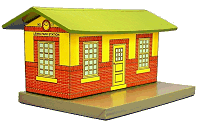 Building a Vintage "Lithographed" Station" - the first article in our "Tribute to Tinplate" series, based on a prewar American Flyer standard-gauge station. Includes free, downloadable graphics, plans, and instructions for modeling in O/S and Large Scale/Standard Gauge. Building a Vintage "Lithographed" Station" - the first article in our "Tribute to Tinplate" series, based on a prewar American Flyer standard-gauge station. Includes free, downloadable graphics, plans, and instructions for modeling in O/S and Large Scale/Standard Gauge.
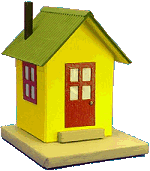 New
Feature - Building a Tinplate-Inspired Watchman's Shanty Back in the day before automated crossings, these were common sites alongside busy rail crossings. Howard's exclusive design pays tribute to a series of tinplate structures that go back a hundred years and include three different scales. His free plans and instructions will help you dress up any indoor railroad or holiday village. New
Feature - Building a Tinplate-Inspired Watchman's Shanty Back in the day before automated crossings, these were common sites alongside busy rail crossings. Howard's exclusive design pays tribute to a series of tinplate structures that go back a hundred years and include three different scales. His free plans and instructions will help you dress up any indoor railroad or holiday village.
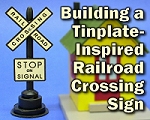 New
Feature - Building a Tinplate-Inspired Railroad Crossing Sign This is the ideal accessory for the Watchman's Shanty project. Based on a series of products that are now available only as expensive collector's items, this easy and almost-free project will add texture, interest, and period to any model railroad or holiday village. New
Feature - Building a Tinplate-Inspired Railroad Crossing Sign This is the ideal accessory for the Watchman's Shanty project. Based on a series of products that are now available only as expensive collector's items, this easy and almost-free project will add texture, interest, and period to any model railroad or holiday village.
- Easy Street Scene - This new
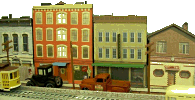 building project uses downloadable building graphics and a little cardboard or foam board to build up a convincing downtown scene that is only a few inches deep - perfect for shelf layouts, tight spots, and dioramas. We also provide links to high-resolution graphics that will work for any scale. building project uses downloadable building graphics and a little cardboard or foam board to build up a convincing downtown scene that is only a few inches deep - perfect for shelf layouts, tight spots, and dioramas. We also provide links to high-resolution graphics that will work for any scale.

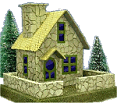 Build a Vintage-Style Cardboard Stone Cottage - This building project is made like the vintage cardboard houses folks used to set around their Christmas tree in the early 1900s (before glitterhouses became common), but its design was inspired by a building that shows up on the "Isle of Sodor." The building uses free downloadable graphic paper to put a realistic stone veneer on an old-world cottage and fence. It works with Christmas villages, or with a little customization, would dress up any indoor railroad. A "brick cottage" option is also shown.
Build a Vintage-Style Cardboard Stone Cottage - This building project is made like the vintage cardboard houses folks used to set around their Christmas tree in the early 1900s (before glitterhouses became common), but its design was inspired by a building that shows up on the "Isle of Sodor." The building uses free downloadable graphic paper to put a realistic stone veneer on an old-world cottage and fence. It works with Christmas villages, or with a little customization, would dress up any indoor railroad. A "brick cottage" option is also shown.
 Log Cabin Building Flat - This "building flat" uses downloadable graphics and foam board or cardboard to dress up a narrow corner of your railroad or village. The techniques in this project can be used for almost any kind of building you want to represent in a tiny space. December, 2007 Log Cabin Building Flat - This "building flat" uses downloadable graphics and foam board or cardboard to dress up a narrow corner of your railroad or village. The techniques in this project can be used for almost any kind of building you want to represent in a tiny space. December, 2007
- Build a Vintage-Style Barn and Silo - This
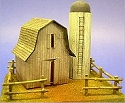 building project uses downloadable graphics to put realistic shingles and siding on an old barn and silo. Like the stone cottage above, it works with Christmas villages, or with a few changes, it would dress up an indoor railroad. building project uses downloadable graphics to put realistic shingles and siding on an old barn and silo. Like the stone cottage above, it works with Christmas villages, or with a few changes, it would dress up an indoor railroad.
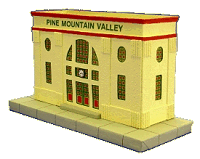 Building the Union Station - This original project by designer Howard Lamey is inspired by two traditions - the cardboard Christmas houses that were popular in US homes between 1928 and 1965 and the Lionel station that was popular for most of the 20th century. Building the Union Station - This original project by designer Howard Lamey is inspired by two traditions - the cardboard Christmas houses that were popular in US homes between 1928 and 1965 and the Lionel station that was popular for most of the 20th century.
Other Articles about cardboard houses include:
|

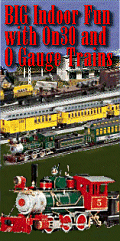
|







 Building a Vintage "Lithographed" Station"
Building a Vintage "Lithographed" Station" New
Feature - Building a Tinplate-Inspired Watchman's Shanty
New
Feature - Building a Tinplate-Inspired Watchman's Shanty New
Feature - Building a Tinplate-Inspired Railroad Crossing Sign
New
Feature - Building a Tinplate-Inspired Railroad Crossing Sign




 Building the Union Station
Building the Union Station 


